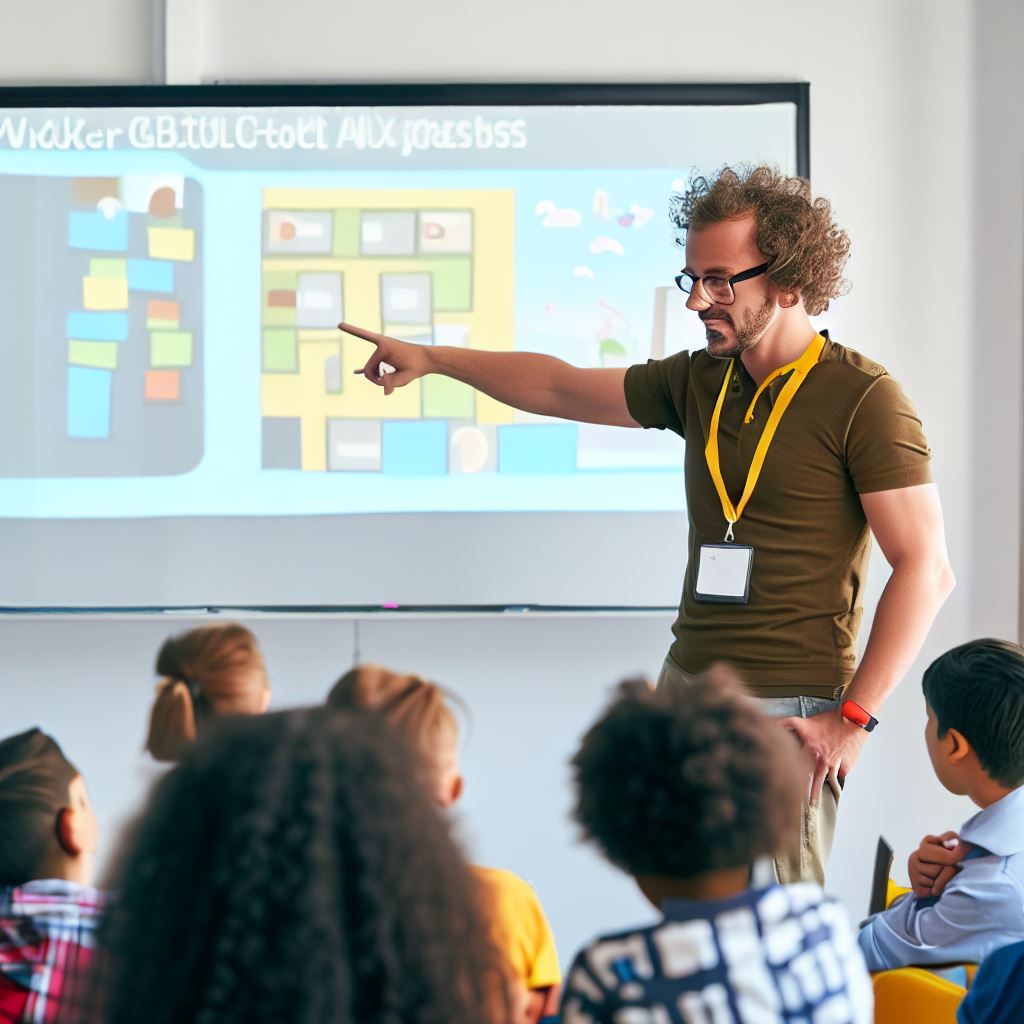Introduction
A. Importance of coding apps in education
Coding apps in education are crucial for preparing students for the digital age.
Imagine a future where all students have the power to create their own technology.
In today’s world, technology is advancing at an unprecedented rate. From smartphones to smart homes, it is clear that our society is becoming increasingly reliant on technology.
As a result, the importance of coding skills in education has never been more evident.
Coding apps in education play a critical role in equipping students with the necessary skills and knowledge to thrive in this digital age.
By teaching students how to code, we are empowering them to understand the fundamentals of technology and become active creators rather than passive consumers.
Imagine a future where all students have the power to create their own technology, solve complex problems, and shape the world around them.
This is the world that coding apps in education can help us build.
By introducing coding at an early age, we are setting students up for success in their future careers, regardless of whether they pursue a STEM field or not.
Not only does coding foster critical thinking and problem-solving skills, but it also encourages creativity and innovation.
Through coding apps, students can unleash their imagination and turn their ideas into reality.
They can create mobile apps, websites, games, and more, gaining a sense of accomplishment and developing a growth mindset.
Coding apps in education are essential for preparing students for the digital age.
By teaching them how to code, we are empowering them to become active creators and problem solvers in our technologically driven world.
Let’s embrace coding in education and provide our students with the skills they need to shape the future.
Benefits of Coding Apps in Education
A. Improved problem-solving skills
- Coding apps help students develop critical thinking and analytical skills by presenting them with coding challenges that require problem-solving.
- Examples of coding challenges include debugging code, finding errors, or creating algorithms to solve specific problems.
B. Enhancing creativity
- Coding apps not only teach students how to code but also allow them to utilize their creativity by creating their own projects.
- Examples of coding apps that foster creativity include Scratch, which enables students to design interactive stories, games, and animations.
C. Fostering collaboration and teamwork
- Coding apps can be used for collaborative coding projects, where students work together to create and solve coding challenges.
- Examples of coding apps that emphasize teamwork in the classroom include GitHub, which enables students to collaborate on coding projects and provide feedback to each other.
Coding apps in education offer several benefits for students. They help improve problem-solving skills by promoting critical thinking and analytical abilities through coding challenges.
Additionally, these apps enhance creativity by allowing students to create their own projects, fostering their imagination and innovation.
Moreover, coding apps encourage collaboration and teamwork through collaborative coding projects, enabling students to work together, exchange ideas, and learn from one another.
Overall, integrating coding apps in education can significantly contribute to students’ development and prepare them for the digital world they will encounter in their future careers.
Read: Balancing Work and a Free Coding Bootcamp: A How-To Guide
Coding Apps for Different Subjects
Coding apps have become increasingly popular in education due to their ability to engage students and enhance learning experiences.
They provide interactive platforms for students to develop coding skills while also integrating various subject areas, such as math, science, and language arts.
In this section, we will explore coding apps designed specifically for different subjects and discuss their benefits.
A. Coding apps for math
- Overview of coding apps that integrate math concepts: Coding apps for math aim to teach students coding skills while reinforcing math concepts.
These apps often present coding challenges that require students to apply mathematical principles to solve problems. - Benefits of using coding apps to reinforce math skills: Using coding apps for math allows students to develop critical thinking and problem-solving skills, as they have to approach coding challenges strategically.
They also gain a deeper understanding of mathematical concepts as they apply them in a practical context.
B. Coding apps for science
- Explanation of coding apps that apply to scientific concepts: There are coding apps specifically designed to help students understand scientific concepts.
These apps provide virtual simulations and interactive experiments that allow students to explore scientific principles through coding. - Examples of coding apps that help students explore scientific principles: Apps like “CodeCombat” and “Tynker” offer science-related coding lessons where students can experiment with physics, biology, and chemistry concepts.
These apps provide a hands-on learning experience and foster a deeper understanding of scientific principles.
C. Coding apps for language arts
- Discussion of coding apps that merge coding with writing or reading activities: Some coding apps have incorporated language arts activities to enhance literacy skills.
These apps allow students to create interactive storytelling projects or coding-infused writing assignments. - Benefits of using coding apps for language arts education: Integrating coding apps into language arts education promotes creativity, critical thinking, and problem-solving skills.
Students can explore storytelling in a unique way and develop digital literacy skills that are increasingly valuable in today’s world.
The coding apps have proven to be valuable tools for teaching various subjects, including math, science, and language arts.
These apps provide engaging platforms for students to develop coding skills while applying and reinforcing concepts from different subject areas.
By incorporating coding apps into classroom instruction, educators can enhance students’ learning experiences and prepare them for the digital age.
Read: Learning to Code? Avoid These Common Mistakes

Incorporating Coding Apps into the Classroom
A. Introduction to different methods of using coding apps in education
In the modern world, technology plays a crucial role in education. One innovative way to enhance students’ learning experience is by incorporating coding apps into the classroom.
Coding apps provide an interactive platform for students to develop coding skills in a fun and engaging manner.
They offer a wide range of activities and challenges that allow students to explore the world of programming.
Tech Consulting Tailored to Your Coding Journey
Get expert guidance in coding with a personalized consultation. Receive unique, actionable insights delivered in 1-3 business days.
Get StartedThere are several methods by which coding apps can be incorporated into the classroom.
These methods can be customized based on the grade level and subject area.
- Integrated Coding Activities: Teachers can integrate coding apps into their regular lessons to reinforce concepts and promote problem-solving skills.
For example, in a math class, students can use coding apps to create programs that solve math equations. - Dedicated Coding Sessions: Teachers can dedicate specific class periods to coding activities. During these sessions, students can work on coding projects individually or collaboratively.
This allows them to focus solely on coding skills and gain a deeper understanding of programming concepts. - Coding Clubs: Schools can establish coding clubs where students have the opportunity to explore coding apps outside of regular class time.
These clubs provide a supportive environment for students to share their projects, learn from each other, and collaborate on coding tasks.
B. Examples of successful classroom activities utilizing coding apps
Many teachers have already implemented coding apps in their classrooms and witnessed positive outcomes.
- Animation Creation: Students can use coding apps to create animations and share their stories with classmates.
By doing so, they develop creativity, storytelling skills, and learn the basics of programming. - Robotics: Coding apps can be used in conjunction with robotics kits, allowing students to program robots to perform specific tasks.
This hands-on activity enhances critical thinking and problem-solving abilities. - Social Studies Simulations: Coding apps can simulate historical events or political processes, enabling students to understand complex concepts in a visual and interactive way.
C. Practical tips for teachers to implement coding apps effectively
Implementing coding apps effectively requires careful planning and consideration.
- Start with simple apps: Introduce coding apps that have a user-friendly interface and offer basic programming concepts.
This allows students to develop a strong foundation before moving on to more complex apps. - Provide guidance: While coding apps are designed to be self-guided, it is important for teachers to provide support and guidance when needed.
This ensures that students stay on track and understand the programming concepts. - Promote collaboration: Encourage students to work collaboratively on coding projects. This fosters teamwork, problem-solving, and communication skills.
- Assess student progress: Regularly assess student progress through coding projects, quizzes, or presentations.
This helps identify areas that need improvement and allows teachers to provide targeted feedback. - Stay up-to-date: Keep up with the latest coding apps and updates to ensure students have access to the most relevant and effective tools.
In essence, incorporating coding apps into the classroom has great potential to enhance students’ learning experiences.
By utilizing different methods, implementing successful activities, and following practical tips, teachers can effectively integrate coding apps into their curriculum.
Read: Learning to Code? Avoid These Common Mistakes
Challenges and Considerations
A. Potential limitations of using coding apps in education
- Coding apps may require access to expensive devices, limiting availability for some students.
- Apps may have limited compatibility with different operating systems, excluding certain students.
- Some coding apps may lack advanced features necessary for comprehensive learning.
- Students with learning difficulties or disabilities may struggle with coding app interfaces.
- App-based learning alone may not provide a holistic coding education experience.
B. Addressing equity and accessibility issues
- Educators can seek funding or grants to provide devices and ensure equal access for all students.
- Choose coding apps that are compatible with various operating systems, including mobile devices.
- Consider using a mix of coding apps that cater to different learning styles and abilities.
- Provide alternative learning options for students with disabilities, such as tactile coding materials.
- Offer supplementary resources beyond coding apps, like textbooks or in-person coding workshops.
C. Strategies to overcome challenges and ensure equal opportunities for all students
- Organize coding app usage in a structured manner, with clear objectives and learning outcomes.
- Offer diverse coding activities to cater to different skill levels and learning preferences.
- Encourage collaboration and peer learning to foster inclusivity and equal opportunities.
- Provide continuous support and guidance to students while using coding apps.
- Regularly assess students’ progress and adjust instructional strategies accordingly.
Using coding apps in education presents certain challenges and considerations that educators need to be aware of.
One potential limitation is the requirement of expensive devices, which can hinder access for some students.
Additionally, compatibility issues with different operating systems may exclude certain students from utilizing coding apps.
It is also important to note that some apps may lack advanced features necessary for comprehensive learning, limiting their effectiveness.
Another consideration is the accessibility of coding apps. Students with learning difficulties or disabilities may struggle with app interfaces, requiring alternative learning options such as tactile coding materials.
To address equity and accessibility issues, educators can seek funding or grants to provide devices and ensure equal access for all students.
It is important to choose coding apps that are compatible with various operating systems, including mobile devices, to reach a wider student population.
Furthermore, using a mix of coding apps that cater to different learning styles and abilities can help address equity concerns.
Providing supplementary resources beyond coding apps, such as textbooks or in-person coding workshops, can offer additional support for students with diverse needs.
By diversifying the learning options, educators can ensure equal opportunities for all students.
Strategies to overcome challenges and ensure equal opportunities include organizing coding app usage in a structured manner with clear objectives and learning outcomes.
Offering diverse coding activities that cater to different skill levels and learning preferences can engage students effectively.
Read: In-person vs. Online Coding Classes for Kids: Pros and Cons
Conclusion
A. Benefits and advantages of using coding apps in education
Using coding apps in education offers numerous benefits and advantages to both students and teachers.
It helps students develop problem-solving, critical thinking, and analytical skills.
It also enhances creativity, collaboration, and communication among students.
Additionally, coding apps provide an engaging and interactive learning environment for students, making the learning process more enjoyable and effective.
B. The future potential of coding apps in the classroom
The future potential of coding apps in the classroom is immense.
Build Your Vision, Perfectly Tailored
Get a custom-built website or application that matches your vision and needs. Stand out from the crowd with a solution designed just for you—professional, scalable, and seamless.
Get StartedAs technology continues to advance, coding skills are becoming increasingly important in various fields.
By incorporating coding apps into the curriculum, schools can equip students with the tools and skills necessary for success in today’s digital world.
Furthermore, coding apps can empower students to become creators and innovators, enabling them to shape the future through technology.
Learn to Code with LearnCode
- Dive into 250 interactive lectures on LearnCode.
- Begin as a novice and emerge as an expert.
- Craft websites, Android, iOS, and desktop apps.
- Master HTML, CSS, JavaScript, PHP, MySQL, Apache Cordova, Node Webkit, and hosting techniques.
- Each lecture comes with an engaging assignment.
- Pose questions directly on any lecture topic.
- Progress at a speed that suits you.
- Earn a professional certificate upon completion.
- Join an exclusive group to monetize your coding skills.
- Parents and guardians can enroll young learners.
Discover the power of coding. Start your journey at LearnCode.
[E-Books for Sale]
500 Cutting-Edge Tech Startup Ideas for 2024 & 2025: Innovate, Create, Dominate
$19.99 • 500 Tech Startup Ideas • 62 pages
You will get inspired with 500 innovative tech startup ideas for 2024 and 2025, complete with concise descriptions to help you kickstart your entrepreneurial journey in AI, Blockchain, IoT, Fintech, and AR/VR.
See All 500 Tech Startup Ideas of this E-Book
How to Code: A Beginner’s Guide to Mastering Programming
$4.99 • 13 Chapters • 32 pages
Unlock programming skills with 'How to Code: A Beginner's Guide.' Start your journey to mastering coding and build your future today.




